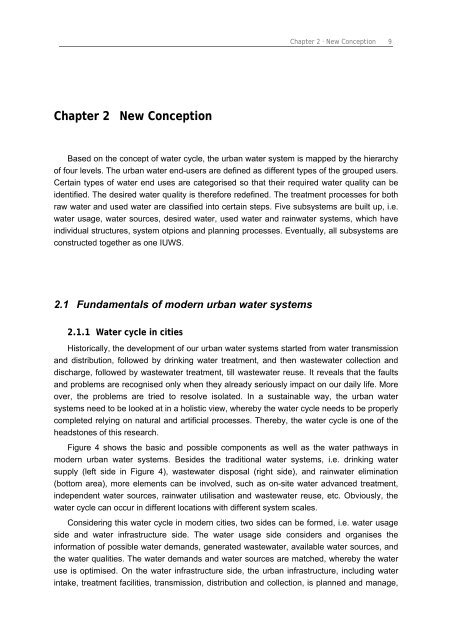Chapter 3 Decision Support Model (IUWS-DSM) - Tubdok
Chapter 3 Decision Support Model (IUWS-DSM) - Tubdok
Chapter 3 Decision Support Model (IUWS-DSM) - Tubdok
You also want an ePaper? Increase the reach of your titles
YUMPU automatically turns print PDFs into web optimized ePapers that Google loves.
<strong>Chapter</strong> 2 New Conception<br />
<strong>Chapter</strong> 2 · New Conception 9<br />
Based on the concept of water cycle, the urban water system is mapped by the hierarchy<br />
of four levels. The urban water end-users are defined as different types of the grouped users.<br />
Certain types of water end uses are categorised so that their required water quality can be<br />
identified. The desired water quality is therefore redefined. The treatment processes for both<br />
raw water and used water are classified into certain steps. Five subsystems are built up, i.e.<br />
water usage, water sources, desired water, used water and rainwater systems, which have<br />
individual structures, system otpions and planning processes. Eventually, all subsystems are<br />
constructed together as one <strong>IUWS</strong>.<br />
2.1 Fundamentals of modern urban water systems<br />
2.1.1 Water cycle in cities<br />
Historically, the development of our urban water systems started from water transmission<br />
and distribution, followed by drinking water treatment, and then wastewater collection and<br />
discharge, followed by wastewater treatment, till wastewater reuse. It reveals that the faults<br />
and problems are recognised only when they already seriously impact on our daily life. More<br />
over, the problems are tried to resolve isolated. In a sustainable way, the urban water<br />
systems need to be looked at in a holistic view, whereby the water cycle needs to be properly<br />
completed relying on natural and artificial processes. Thereby, the water cycle is one of the<br />
headstones of this research.<br />
Figure 4 shows the basic and possible components as well as the water pathways in<br />
modern urban water systems. Besides the traditional water systems, i.e. drinking water<br />
supply (left side in Figure 4), wastewater disposal (right side), and rainwater elimination<br />
(bottom area), more elements can be involved, such as on-site water advanced treatment,<br />
independent water sources, rainwater utilisation and wastewater reuse, etc. Obviously, the<br />
water cycle can occur in different locations with different system scales.<br />
Considering this water cycle in modern cities, two sides can be formed, i.e. water usage<br />
side and water infrastructure side. The water usage side considers and organises the<br />
information of possible water demands, generated wastewater, available water sources, and<br />
the water qualities. The water demands and water sources are matched, whereby the water<br />
use is optimised. On the water infrastructure side, the urban infrastructure, including water<br />
intake, treatment facilities, transmission, distribution and collection, is planned and manage,

















